Recent Posts
How To Prevent Water Damage While Vacationing
8/16/2022 (Permalink)
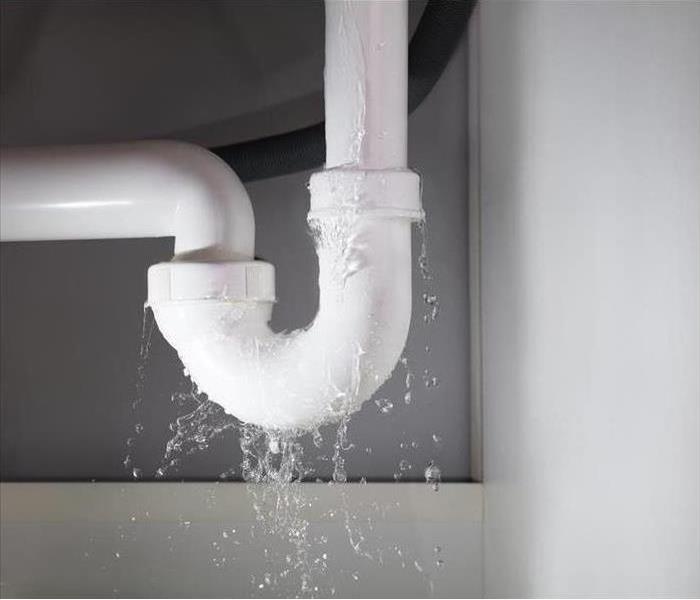 A leaking pipe in a Clearfield, UT, home.
A leaking pipe in a Clearfield, UT, home.
When you are on vacation, the last thing that you want to do is worry about broken water pipe repair. Unfortunately, it does happen when you least expect it. There are some things that you can do to prevent this kind of damage while you are away from Clearfield, UT.
3 Things To Do To Prevent Water Damage While Away
1. Check for Leaks
This may seem obvious, but you should make sure nothing is leaking before you leave. Be sure to check your:
- Toilets
- Pipes
- Sprinklers
- Hoses
- Water heater
A broken pipe can be extremely bad while you are on vacation because it will continue to leak until you come back. If one does break, mold could grow, and you will need a remediation company to clean up the water damage.
2. Insulate, Disconnect and Caulk
Even warmer climates can freeze in the winter. By insulating and caulking around exposed pipes, you can prevent needing a water pipe repair while you are away. You should remove any hoses and cover the spigots of any outdoor water access to prevent these from becoming a problem.
Keep your heat on low when you are not there to prevent indoor pipes from freezing. Remember, when indoor or outdoor plumbing freezes, it can cause a pipe to break, creating leaks at the very least.
3. Turn Off the Water
The best way to avoid coming home to a flooded house is to turn the water off at the main. You can do this by shutting off the main and draining out any excess water. If turning the water off isn't an option, consider having someone watch your house while you are not there. They can turn on the heat in the event of a freeze and notify you if there are any problems.
No one wants to worry about broken water pipe repair while they are on vacation. You can prevent everything from damaged walls to pipes bursting with these simple steps.
Exploring the Fire Restoration Process for Your Business
7/25/2022 (Permalink)
Business owners like yourself need to be prepared for disasters, especially as part of an overall plan for workplace safety. Commercial fires not only pose a safety threat to your workers but they can also put your business at risk, especially if there’s a long interruption to your business. It’s critical to have a plan for recovery after a fire for your commercial property in Clearfield, UT. Knowing the steps to take ahead of time is critical, and can help you bounce back sooner from a fire-related disaster.
Creating a Fire Restoration Plan
After a fire has been completely extinguished, your recovery process should include the following actions:
- Documentation: Take several photos of the damage to your building and the objects inside. Make a note of anyone that you talk to, including officials, property managers or landlords. It’s critical to capture things as they are with photos and video. Do not touch impacted objects, and hold on to any invoices or receipts for expenses.
- Claims: Call your fire insurance company or representative as soon as possible. It takes time to process your claim, which can delay any payments you may need to make repairs or keep your business going.
- Professional Restoration: Notify a professional fire restoration or remediation services company. This company is experienced and equipped to find the most expedited and efficient way to restore your building to pre-damage conditions.
- Contingencies: Execute any contingency plans, which often include notifying clients, workers, subconsultants and other interested parties about the fire. Your plans should include special arrangements and changes to contractual agreements, where applicable.
- Security: Depending on the size of the fire and its impact, you may need to secure parts of your business to prevent damage and other types of loss, such as theft or vandalism.
- Offsite Removal: Any unaffected items should be removed so that they’re not damaged or destroyed during restoration or reconstruction.
Cleaning Up Your Space
When it comes to a fire, there may be other types of damage to consider. Smoke and soot can leave your interiors and items heavily soiled and damaged, requiring special cleaning techniques that only a professional fire remediation provider can handle. Any water used to extinguish the fire, whether by sprinklers or a fire hose, can also cause damage that requires cleanup and repair. From smoke cleaning to advanced drying techniques, you’ll be glad to have professionals on board to clean and restore your building.
Considering Insurance
In most cases, fire restoration costs can be covered by a fire insurance policy. Before a disaster occurs, it’s a good time to check to see if your coverage levels are sufficient. You may need additional coverages based on your operational needs. For example, umbrella policies often extend your coverage limits in the event of a catastrophic loss. The recovery period may be significantly longer than you planned, so business interruption or income interruption policies may help you with ongoing expenses, temporary costs, or other bills needed to keep your business open.
Understanding the fire restoration process helps you come up with a realistic recovery plan. Having such a plan can help expedite the time it takes to get back to business after a commercial fire in Clearfield, UT. It’s easier to dot all the I’s and cross all the t’s before disaster strikes.
How Commercial Owners Can Minimize Sprinkler Flooding
7/25/2022 (Permalink)
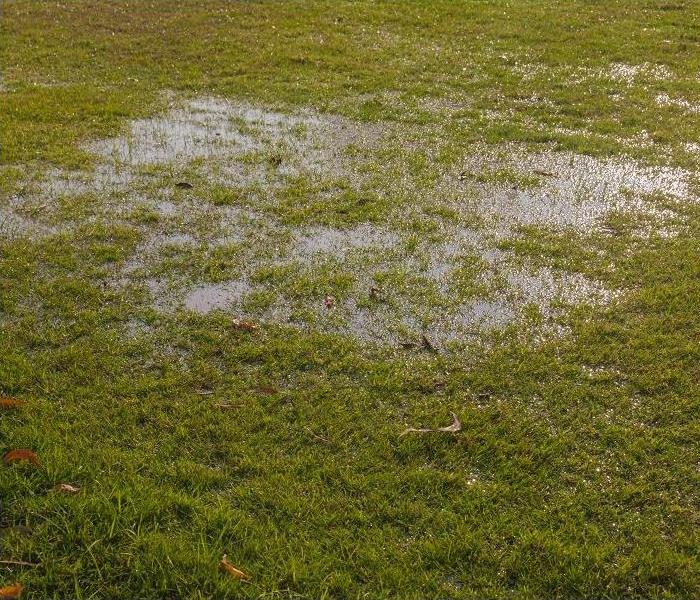 A broken sprinkler can cause flooding
A broken sprinkler can cause flooding
Keeping your commercial property in Clearfield, UT, lush and green is ideal, reflecting a pristine and attractive setting. However, that's not the only reason to focus on sprinklers. Proper irrigation maintenance minimizes several concerns, decreasing the company's utility costs and flooding probability.
Stopping Floods: The Importance of Irrigation Maintenance for Commercial Properties
According to the Environmental Protection Agency, EPA, a small leak has a significant impact. Even something the size of a dime could allow as many as 6,300 water gallons per month to go to waste. This loss adds to the water bill and begs the question: where does all that water go? It could seep into the soil, or it could flood the building. Adopt the following habits to catch issues and avoid water damage quickly.
1. Evaluate the System Regularly
You can program irrigation systems to go on at your will, setting automatic timers; this option offers you flexibility but limits your oversight. You won't know if something breaks or leaks. Therefore, set aside time to inspect the sprinklers before kicking them on.
The unit has multiple pieces, and they're vulnerable to issues. People can easily affect a sprinkler head placement by stepping on it or running equipment over it. Simple, everyday actions move spray direction or prevent operations. Thus, check each of the following pieces to see if they function correctly:
- Lines
- Heads
- Controller
- Nozzles
- Valves
If anything is slightly off, your land may not get what it needs. In addition, water could accumulate quickly, building up a flood. Move pieces into proper places and replace anything not working.
2. Look for Signs of Trouble
The potential for sprinkler flooding increases when you have something awry, and sometimes the land tells you more than the sprinklers themselves. Therefore, observe the grounds for changes or unusual appearances such as dryness, dips or puddles.
Pay close attention to the heads and nozzles. Is the water flowing evenly, or is it building around the piece? Intense sprays and low pressure indicate potential leaks or breaks.
If you cannot see a physical sign of distress but think something is off, contact a water remediation team for help. These professionals can use cameras to inspect the lines, determining where a breach has occurred.
3. Know How To Handle Floods Quickly
When a flood does occur, it's imperative to react quickly and appropriately. As part of your irrigation maintenance plan, prepare protocols for handling instructions. After all, water harms the building's structure, dampening materials and encouraging mold and mildew. What may seem harmless could create significant devastation. Have the phone number for water restoration specialists in Clearfield, UT, and call them as soon as you observe puddling or damage.
4. Get an Annual Inspection
Have experts review your irrigation system at least once a year, especially in the spring. Many companies turn off the designs in the winter. A lot of things can happen during those cold months. Professionals can assess the parts, fix anything amiss and get you on the right track for the warmer days.
Broken sprinklers increase the chance of a flood.
Protect your commercial property by prioritizing irrigation maintenance and checking your sprinklers before turning them on.
Consider Calling a Professional for Sewer Backup Cleanup
7/20/2022 (Permalink)
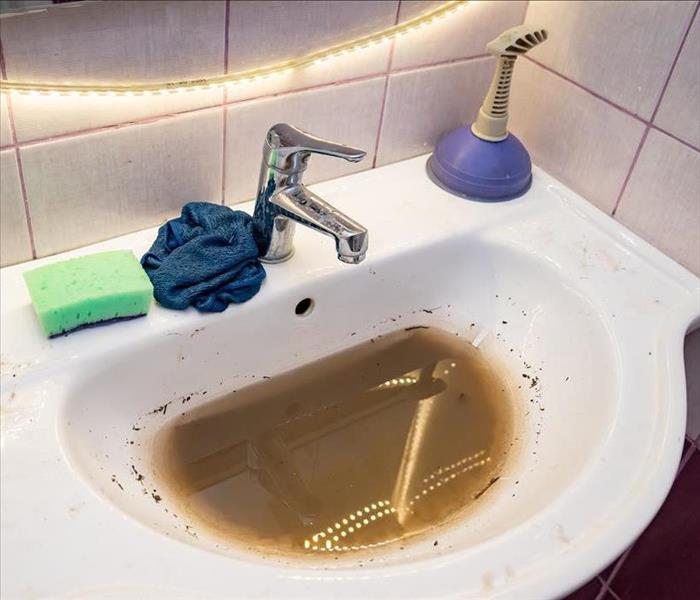 Sewer backup
Sewer backup
From hearing gurgling sounds while flushing to noticing a bathtub backup or noticeable odors when running water in a sink, there are many indications that your Clearfield, UT, home has a sewer backup. After the mess happens, it is important to consider the cause and take the proper steps for safe cleanup.
Common Backup Causes
While some sewer issues may be out of your control, there are common culprits that may be preventable. Key causes include:
Clogs: Like your drains, sewer lines also get clogged. The easiest way to avoid both types is to ensure everyone in the home only flushes what is meant to be flushed down the drains or toilet.
Tree Roots: Depending on the type of material your plumbing is made out of, they may be prone to damage by tree roots. Roots may easily find a way in and create cracks that may lead to a line collapse. Although difficult to prevent, switching to plastic pipes or having a plumber regularly clean the main line can stop a bigger issue.
Sewer Main Issues: Unless your home has its own septic system, the plumbing in it all leads to the same main city sewer. If that main has an issue, it may affect an entire neighborhood. Heavy rainfall is often the cause of this type of sewer issue.
Steps for Sewer Backup Cleanup
Anytime there is a water issue associated with the sewer, it should be approached as if it was caused by natural flooding. That means considering it contaminated water that needs to be properly taken care of. If dealing with a small amount of water, it may be a relatively easy cleanup. If the mess is large, it’s recommended to contact a water damage cleanup and restoration company to ensure your home is returned to a safe environment.
Regardless of the situation you find yourself in, here are key steps when dealing with sewer water:
- Prior to cleanup, ensure that the water hasn’t risen high enough to reach any electrical outlets. If it has, turn off the power and contact an electrician to ensure it is safe to enter the area.
- Wearing protective gear is a must. This should include eye protection, a face mask, rubber boots and disposable clothing.
- During cleanup, ensure the main water line valve is shut off. Even if another area of the home isn’t affected, using a sink or toilet may cause an additional backup.
- If possible, open any windows in the affected area to get proper ventilation.
- The most important part of the cleanup process is removing the water. A wet/dry vacuum may quicken this process.
- Determine which belongings may or may not be salvageable. Items that are made out of a porous material may need to be properly disposed of.
- The final steps require cleaning and sanitizing every part of the affected area.
Dealing with a sewer backup isn't as simple as mopping up. Prior to dealing with the mess, it is important to determine the cause of the problem and follow safety guidelines when handling the contaminated water.
Tips for Repairing Your Roof After a Storm
7/12/2022 (Permalink)
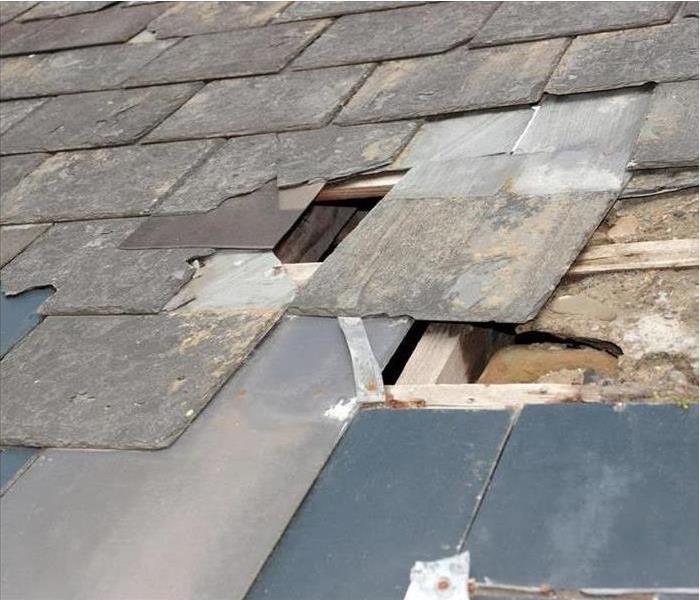 A storm may leave severe roof damage.
A storm may leave severe roof damage.
A dangerous storm in Clearfield, UT, can cause more than just flooded streets. It may also wreak havoc on your home. Hail and debris caught in wind currents can leave you in need of some serious roof repair. Knowing the right steps to take can help you minimize overall damage and protect your home.
3 Tips to Minimize Damage After a Storm
1. Contact Repair Professionals
Before you can fix the problem, you need to know how much roof damage you have. Roofing professionals are trained to spot problem areas:
- Broken or missing shingles
- Damaged flashing
- Dented gutters and spouts
As soon as they know what they need to fix, they can start the repair process. They replace broken materials and get your roof back to normal.
2. Board Up Vulnerable Spots
An important part of the roof repair process is protecting the vulnerable spots that the storm left behind. If your roof has a lot of damage, the technicians may not be able to fully restore it in one visit. In the meantime, you will need board-up services to keep additional precipitation, dirt and pests from getting into your home through the open spaces.
3. Inspect Interiors
Exterior hail and wind damage are not the only issues you need to address. If the protection your roof offers is compromised, you may also have some water damage inside your attic. Storm damage mitigation experts can find the problem and remedy any issues that roof leaks have caused. The faster they are able to tackle the problem, the less secondary damage you'll have to worry about.
There are multiple factors that could cause serious damage to your home during a storm. Hail, high winds and heavy rain can lead to costly roof repair. It is important to call for a professional inspection right after the storm passes so that any necessary repairs and mitigation can start as soon as possible. Protect your home from further damage by acting quickly.
Factors To Consider When Buying a Smoke Detector
6/22/2022 (Permalink)
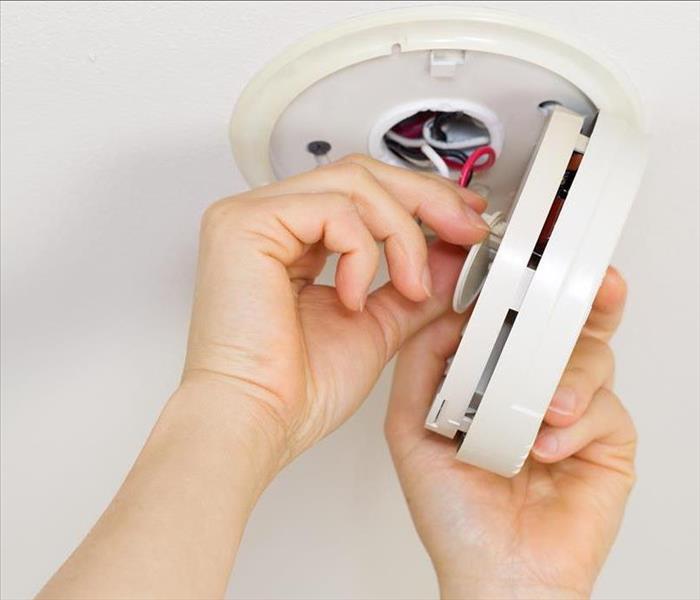 Know more about your Smoke Detectors and avoid Fire Damage in your property.
Know more about your Smoke Detectors and avoid Fire Damage in your property.
While you may hope that flames never touch your place in Clearfield, UT, the reality is that blazes happen. The Nation Fire Protection Agency reports that between 2015 to 2019, approximately one-quarter of fires occurred within homes. Furthermore, fire crews attended to at least 346,800 residential fire-related calls.
During these dire times, a smoke alarm serves as the first line of defense, signaling trouble and helping people escape.
Tips for Picking the Right Smoke Alarm for Your Home
Like any device, alarms break or deteriorate with age. They should last about 7 to 10 years. However, life happens, and you may need to upgrade sooner. It's essential to check them every six months, replacing batteries at that time and ensuring they work correctly. The following are signs of a broken or malfunctioning unit:
- Constantly chirps or beeps
- Color lights don't match the book guides
- Reacts suddenly without cause
- Fails to go off during testing
If you have a smoke detector with one of the following conditions, it's time to grab a new one. Use the following information to invest in the right option to safeguard your home.
1. Understand the Initial Layout and Connections
Know how the builders installed detectors. They may have put in hard-wired or battery-powered units. Keep the same format, although can swap out for different manufacturers. Hard-wired selections are connected throughout the home. When one is triggered, they all go off, creating additional noise and, perhaps, more warning. These devices often require an electrician's help.
Battery-operated devices are not connected and work as individual parts; people often find them more manageable to change on their own.
2. Pick Your Sensor
Discuss how you want smoke detected within the home. This interest influences your smoke alarm investment. Choose between photoelectric and ionization models. Do you want something that identifies flames? Photoelectric products recognize light; thus, they trigger with sparks. Ionization detectors act differently. They react with smoke. There are dual-sensor selections that pick up both.
3. Determine Your Need for Noise
Think about your home's size and the occupant's age and hearing. Those with smaller buildings and middle-aged, average-hearing adults may rely on traditional beeping units. These go off within the immediate vicinity, helping with fire safety measures. For instance, if a fire starts in the kitchen, the noise reacts nearby. Others hear it and can escape.
However, if you live in a larger home with multiple levels and rooms, you may not immediately recognize the noise. In addition, those with weaker hearing or younger kids may struggle too. Interconnected units increase the volume, allowing people to receive notifications throughout the home.
In addition, little ones may respond to voice alarms that indicate where the flames are located, helping avoid the area and find a suitable place for escape.
4. Get Profesional Input
Ask fire restoration experts to assess your home in Clearfield, UT, determining if you have enough smoke detectors. In addition, these specialists can advise you on whether you need additional units or should move alarms or upgrade them to meet safety codes.
When you're ready to purchase a smoke alarm, reflect on your home's original design and your current lifestyle. Select options that improve your escape plans and help loved ones find safety.
The Dangers of Secondary Damage After a Water Event
6/17/2022 (Permalink)
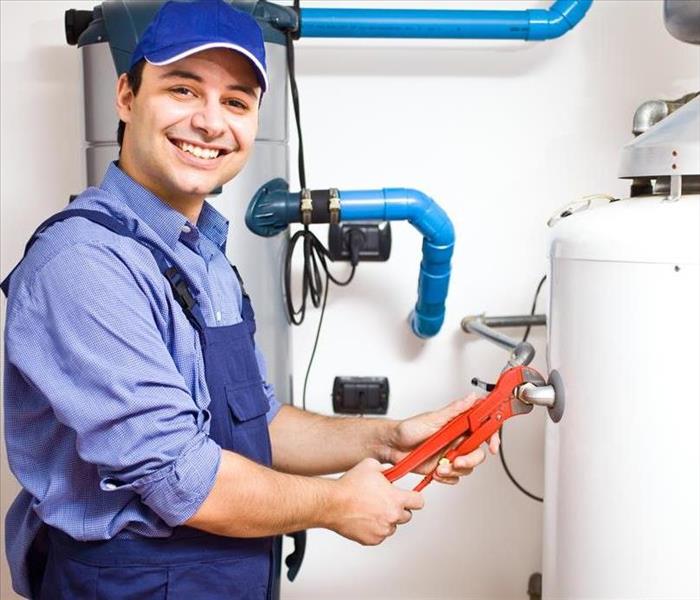 Our Specialists are ready to help After a Water Event. For more information, just contact us.
Our Specialists are ready to help After a Water Event. For more information, just contact us.
If your home in Clearfield, UT, suffers from any type of water damage, it could be susceptible to additional concerns after the initial cleanup. This could occur just a few days later or it could begin to reveal itself a week or two down the road. While black mold is one of the big concerns when water leaks into your home, you also need to be on the watch for lingering smells, deteriorating materials and spoiled carpeting.
The Best Defense Against Secondary Damage
A professional cleanup and restoration from an established water mitigation team is the best way to make sure the recovery process proceeds smoothly. The work will be done by highly-trained technicians who have been certified in the best techniques to clean up a house impacted by heavy storms, flooding or faulty plumbing.
Using standards accepted by the cleaning and restoration industry, the technicians will follow a checklist of proven procedures:
- Respond quickly to the situation
- Develop a sound restoration plan
- Remove standing water from the home
- Reduce areas of high humidity
- Restore and rebuild damaged areas
Lingering moisture can create the perfect conditions for black mold to form and grow on structures throughout your home. A professional team will make sure to treat excess moisture through proper ventilation, drying techniques and the use of fans. Technicians will also take measurements to determine the moisture level in the home, reducing it to about 30 to 60% indoor relative humidity so mold is unlikely to gain a foothold.
The Keys to Eliminating Odors
A poor cleanup job can lead to unpleasant odors after the work crew has left. These will only grow stronger over time, and they also hint at a harmful moisture level. Trained professionals will remove items that are too saturated to restore. This could include drywall, carpeting and insulation. Advanced techniques are used to remove wet insulation and replace it with new materials. Spoiled carpeting and padding will also be torn out and new carpeting will be installed if the damage is too great.
Specially formulated cleaning agents will be used to sanitize the home, killing pathogens and microbes that can grow and cause further damage. This helps deodorize the home. Unless the home is thoroughly cleaned with safe and effective agents, the possibility of returning smells is always possible.
The Answer to Black Mold Growth
Mold enjoys moist conditions and is more likely to trouble your home after any type of water leak or damage. All types of mold are potentially harmful to a home and they are all hard to eradicate as they leave microscopic spores that can colonize a new outbreak. This is especially true if your home still has high humidity levels or if the offending mold spores were not killed by powerful cleaning agents.
While a water leak in your home in Clearfield, UT,, is a challenging event, a professional cleanup and restoration process should take care of most issues. It will also make sure secondary damage in the form of mold growth or unpleasant odors does not cause trouble later on.
Water in Home: How To Clean Wet Items
6/13/2022 (Permalink)
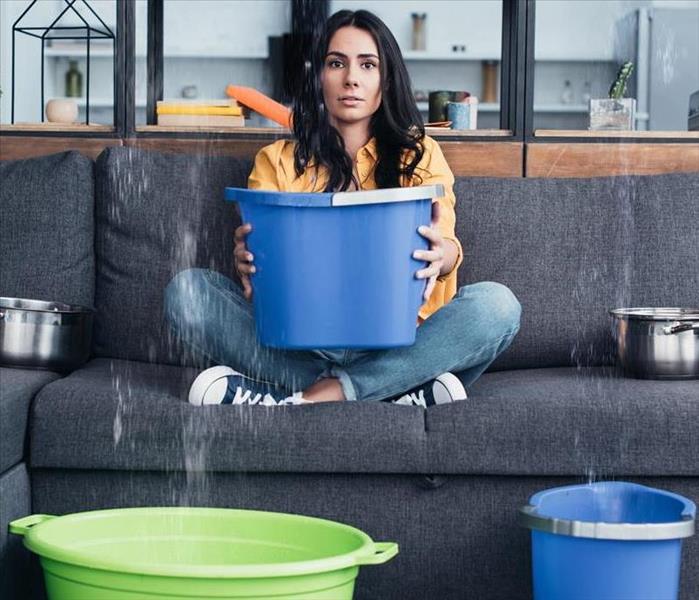 Clean Wet Items with the help of our Professionals.
Clean Wet Items with the help of our Professionals.
Whenever you have water in home it isn't just the structure of your home you have to worry about. You must also deal with all of your water-damaged belongings. Some water-damaged items must be replaced; however, if you use the correct techniques, some items can be saved.
Restoring Water-Damaged Items After Water in Home
It is important to act fast when you have water damage in your home. Within 24-48 hours mold and mildew can develop. Restoring your damaged property is a multi-step process:
1. Stop the Water
If the source of your water problem is a broken pipe or another leak, take steps to stop the water before you move on to drying out your property. You may need to shut off your home's water supply or board up or put a tarp over leaks while you wait for repairs.
2. Prioritize
Because it becomes more difficult to restore your property the longer it remains wet, start with the most important and fragile items first. Begin with any important documents, photographs and artwork you want to save. Next, sort through clothing and fabrics. Finally, examine appliances, furniture and electronics.
3. Start Indoor Air-Drying
If the weather isn't too humid, open the doors and windows of your home to increase air circulation. Set up fans and dehumidifiers to assist with the drying process.
4. Dry Papers and Photos
Spread papers out on top of clean, absorbent materials. As the papers dry, change out the towels or pads you are using to dry them. Gently rinse photographs with clean water and allow them to air-dry on plastic screens or paper towels.
Insert paper towels between the pages of books and then stand the books upright with the pages fanned open to dry. If you can't immediately begin drying papers, photos and books, you can slow down the damage by placing them in plastic bags in the freezer.
5. Call a Professional
Most artwork needs professional restoration services. You may also want to consider contacting a restoration service in Clearfield, UT, to help you restore any particularly valuable documents or photographs.
6. Clean Clothing and Other Fabrics
Brush any dirt and debris off fabrics that require dry cleaning and then take them to the dry cleaner. Run a full cycle using chlorine bleach, detergent and hot water to clean and disinfect your washing machine.
Rinse debris and mud from your damaged clothing and fabric items with a water hose. Use cold water and a heavy-duty detergent to run a pre-wash cycle. Wash clothing and fabrics in the hottest water that is safe for the material. If items still have dirt or stains, try washing them again.
7. Wash and Dry Wood Furniture
Use a hose to rinse your wood furniture and then apply wood alcohol or turpentine to prevent mold. Allow wood furniture to dry inside your home if possible. Placing wood furniture in the sun can cause it to warp. Upholstered furniture can be difficult to save. You may want to allow a restoration company to clean these items.
Despite your best efforts, you probably will not be able to save all of your belongings that have been damaged by water in home. However, if you take the proper steps you can save some items.
Can Wet Materials Be Salvaged?
6/7/2022 (Permalink)
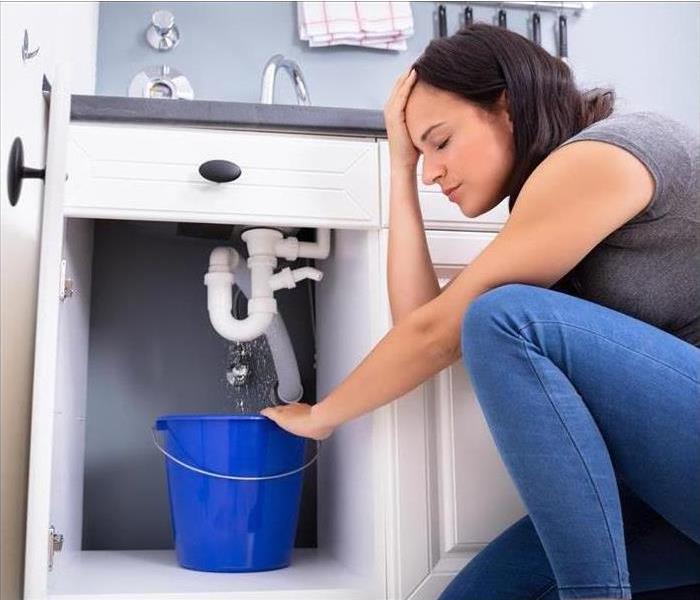 Avoid further damage in your Clearfield, UT property by following our Tips.
Avoid further damage in your Clearfield, UT property by following our Tips.
Routine home maintenance is a good way to identify a water loss. If a sudden loss occurs in your clients' home in Clearfield, UT, however, it can cause a lot of damage such as swelling wood in a short amount of time. The water restoration experts you recommend to your clients can lower the cost of their claim by identifying materials that can be dried rather than replaced.
Identifying Contamination Level
One factor that determines whether materials must be torn out is the level of bacteria present in the water. There are three main levels of contamination that can occur in homes:
- Category 1 - clean water from a pipe or supply line
- Category 2 - dirty water from an appliance leak
- Category 3 - contaminated water from sewage or storm flooding
The cleaner the water, the more likely it is that affected materials will be able to be saved. For example, wet drywall can usually be dried thoroughly. If, however, the wall is also laden with bacteria, it may need to be torn out and replaced, which will likely result in a higher claim cost.
Determining Saturation Level
Hardwood floors are particularly susceptible to water damage. Swelling wood or buckling floorboards are both telltale signs that the flooding has damaged the floor beyond repair. In addition to quick water pipe repair, early detection is the key to minimizing the risk of this happening. The longer standing water sits on the floor, the more damage it causes. When you make SERVPRO a preferred vendor, you can rest assured that the technicians will arrive in a timely manner so that they can catch water damage before it goes too far.
Your clients may not be able to avoid replacing swelling wood or contaminated materials, but a lot of water damage can be repaired if they catch it early enough. Referring them to reliable mitigation experts reduces their claim and thus your payout.
How To Minimize Water Damage After a Burst Pipe
6/7/2022 (Permalink)
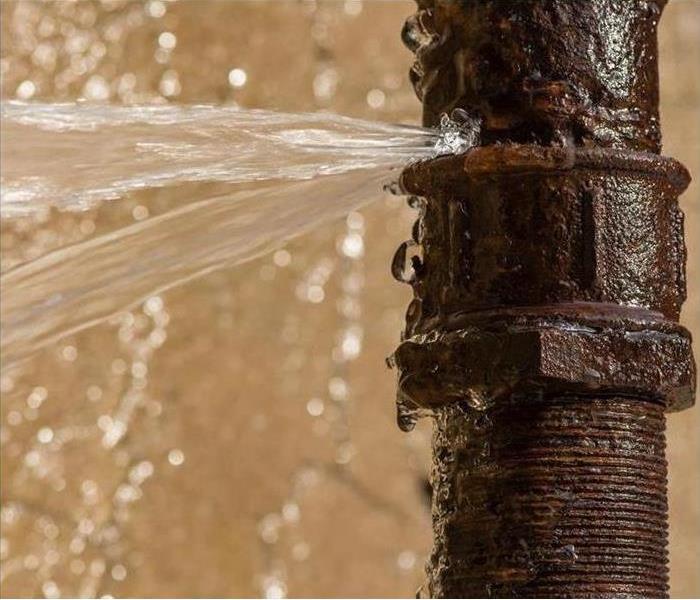 Trust the professionals and Minimize Water Damage.
Trust the professionals and Minimize Water Damage.
Discovering a broken pipe in your Clearfield, UT, commercial building can be an anxiety-provoking event. Seeing standing water inside might have you in a panic, wondering what to do next. You probably won't be able to prevent water damage after a pipe burst, but there are steps for keeping it to a minimum.
- Shut Off the Building's Main Water Supply
First, you need to shut off the building's water supply at the main valve to stop the influx. This action will minimize the flooding and standing water as much as possible.
- Examine the Area for Damage
After you've stopped the water flow, it's essential to examine the area thoroughly. Be sure to locate all the affected areas and materials.
- Extract the Water
Next, the standing water inside needs to be removed as quickly as possible. Every minute counts when it comes to a moisture problem, whatever the size. Typically, the most efficient way of extracting standing water is by using a wet/dry vacuum. It can safely and quickly remove the liquid and smaller floating debris.
- Dry the Area
You must dry the area thoroughly after water pipe cleanup. The more prolonged moisture lingers in the area, the more damage will occur from water and mold growth. Mold can begin growing within 24 hours of water contact, so it's essential to dry it as quickly as possible. Use dehumidifiers, fans, heat, and open windows and doors.
- Contact Professionals
After a pipe burst of any size, it's most beneficial to call professionals, such as plumbers and flood damage restoration professionals. They'll thoroughly inspect the area and repair any damage, from the broken pipe itself to mold remediation.
Flowing water inside your building is never a good thing if it's due to a broken pipe. You can't always prevent these occurrences, but knowing what to do beforehand helps minimize the loss.



 24/7 Emergency Service
24/7 Emergency Service








